Estrus detection has always been one of the most important topics to discuss when implementing an A.I. program in a dairy herd. With the changes physiologically correlated with the modern, high-producing dairy cow, visual observation of estrus has become more challenging. Cows are presenting this behavior during a shorter time interval, with less intensity and with less standing events as milk production increases.
In an attempt to overcome these challenges, the development of the fixed timed-A.I. (TAI) protocols, such as Ovsynch and its variations, was one of the most important steps to manage reproduction among these high-producing dairy herds, with cows receiving A.I. after the completion of a synchronization protocol, leaving the necessity of estrus detection out of the equation.
There is a strong correlation between estrus behavior and increase in physical activity. Since the early 1970s, with pedometer technology, dairy farmers were able to count steps, and by correlation, perform A.I. in cows with an increase in the number of steps taken in a day.
The newest version of activity monitors for dairy cows is now taking into consideration the overall activity of cows with a tri-dimensional activity sensor, also called an accelerometer, and based on a standard deviation of a base activity line for a specific cow, calculated by a complex logarithm. Dairy farmers have another good tool to identify and breed animals presented in estrus.
When is the ideal time to inseminate?
One of the most important questions to be answered when an estrus detection aid is incorporated to the management is: Based on the information presented by the activity monitor, when do animals ovulate after this increase in activity? Therefore, when is the ideal time to inseminate this animal after its increase in activity?
To answer this question, the dairy science department at the University of Wisconsin – Madison performed an experiment on a 1,000-cow commercial dairy farm in southwest Wisconsin. On this first trial, cows received a protocol (gonadotropin releasing hormone, or GnRH) injection on day 0, prostaglandin (PGF2α) injection on day 7 and estrus observation after PGF2α to induce estrus behavior.
Cows had their ovaries scanned by ultrasound, and blood samples were taken for progesterone (P4) concentration at every injection and then again two days after the PGF2α injection. Only cows with a follicle larger than 10 mm in diameter and high concentrations of P4 at PGF2α, and low concentration of P4 two days later, were included in the analysis.
In other words, cows that followed the protocol and were perfectly set up to come in estrus after a PGF2α injection were included. Then, cows were scanned three times a day to assess timing between increase in activity and ovulation, and between ovulation and time of insemination.
The mean interval from onset of activity to ovulation was 28.7 hours, and the mean interval from A.I. to ovulation was 7.9 hours. Cows received A.I. based on the a.m./p.m. rule (twice a day), which in average allowed the right time for sperm capacitation (six to eight hours) before ovulation.
On average, the numbers are in accordance with previous data reported for cows monitored after estrus expression either by visual observation, electronic pressure-sensing systems or pedometers.
The major concern is in regard to the wide variation of the interval between the time of A.I. and ovulation (with a minimum of less than 12 hours and maximum of 26 hours), where a good proportion of cows received A.I. on the ideal interval (zero to 12 hours), but still, cows received A.I. either too early (less than zero hours) or too late (more than 12 hours), as shown in Figure 1 .
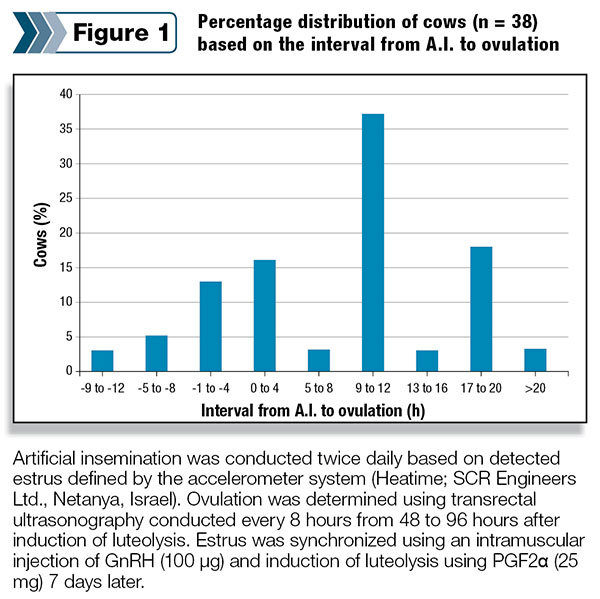
Based on the data, it may be helpful to reduce the variation in the A.I.-to-ovulation interval so that more cows are inseminated at the optimal time in relation to ovulation. Alternatively, cows could be inseminated a few hours earlier to reduce the probability of inseminating cows after or near the time of ovulation.
The surprise behind this trial was the proportion of cows that were included in the analysis and effectively showed estrus activity after the PGF2α injection (induction of luteolysis) and the proportion of cows that did not.
Based on the accelerometer system ( Table 1 ), 71 percent of cows were detected in estrus (among them, 95 percent of cows ovulated), and 29 percent were not detected in estrus even though they were set up to present such behavior. Among the 29 percent of cows not showing estrus, 35 percent of them underwent ovulation.
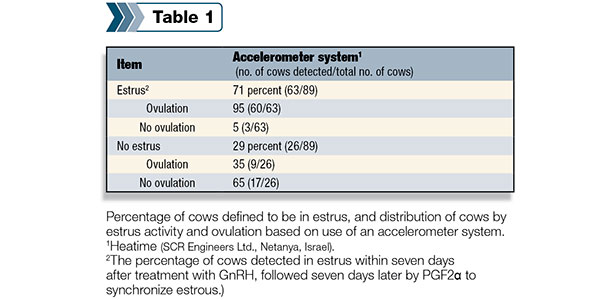
After our analysis of this first trial, we observed that almost 30 percent of the cows that did not show estrus were actually in accordance of what usually happens in dairy farms when cows are enrolled on a Presynch-Ovsynch type of protocol (two PGF2α injections during the voluntary waiting period, 14 days apart, estrus observation and A.I. in cows that display estrus after the second PGF2α injection, and enrollment in the Ovsynch protocol 12 days later to submit cows that were not inseminated in estrus to the TAI).
On these protocols, depending on the aggressiveness of the estrus detection practice in place, we observe that 25 percent to 35 percent of cows end up being submitted to the TAI protocol.
Now, the question was: How is the best way to incorporate the activity monitors to the herd’s reproductive management without taking so long to submit these cows that are not showing estrus to an A.I.?
In an attempt to answer this question, our same group at UW – Madison performed a trial to compare the efficiency of reproduction management with cows receiving A.I. after detection of natural or induced estrus with cows receiving 100 percent TAI. We will discuss groups 2 and 3 of this trial ( Figure 2 ).
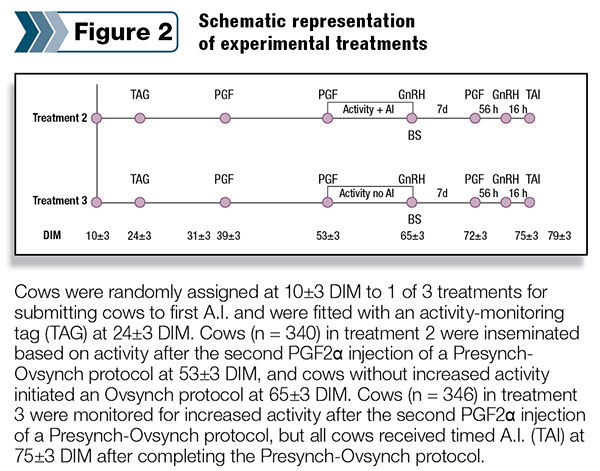
Cows were enrolled on a Presynch-Ovsynch protocol in these two groups. In one, cows were inseminated in estrus detected by the activity monitors after the second PGF2α injection of the pre-synchronization protocol, also known as “cherry-picking,” and cows not inseminated in estrus received TAI, with the Ovsynch portion of the protocol starting 12 days after the second PGF2α injection.
In the other group, cows received the same hormonal treatment, with the difference that all cows were submitted to TAI at the end of the protocol. Even though this group of cows was not inseminated in estrus, the activity data was recorded and included in the analysis.
In both treatments, the same proportion of cows had increased activity after the second PGF2α injection of the Presynch protocol (69 percent for treatment 2 and 70 percent for treatment 3). Cows in treatment 2 that were inseminated after detection of estrus based on increase in activity had 30 percent pregnancy per A.I. (P per A.I.), and cows submitted to the Ovsynch portion of the protocol had 36 percent P per A.I.
On treatment 3, all cows were submitted to TAI but were divided in cows with or without increase in activity. Cows with increases in activity during the period between the second PGF2α and the completion of the TAI program had 41 percent P per A.I., and cows with no increase in activity had 35 percent P per A.I.
Overall, including all cows in each treatment, cows in treatment 2 had 32 percent P per A.I. (A.I. in estrus plus TAI), and cows receiving 100 percent TAI on treatment 3 had 40 percent P per A.I., with a statistical advantage for the TAI program in P per A.I.
However, when an economic analysis was performed to compare these treatments to account the effect of treatment on reproductive performance, according to the conditions stipulated on different scenarios and under the reproductive performance observed on this trial, a small difference was observed between these two treatments ($2,732 per cow per year compared to $2,736 per cow per year for treatments 2 and 3, respectively), assuming that the same reproductive strategy was used for second and subsequent A.I.
These results suggest that both strategies are economically viable and could be used alternatively by dairy farms that incorporate an activity monitoring system for detection of estrus and A.I.
The future of activity monitors systems
Companies offering activity-monitoring systems are incorporating one feature that promises to be the future of cow health monitoring to maximize efficiency in overall health and reproduction management.
The incorporation of a rumination (based on a tuned microphone attached to the activity neck tag, Figure 3 ) or feeding monitor (based on head movements also on the neck tag, Figure 4 ) features not only add more data to strengthen the estrus detection based on an increase in activity and decrease in rumination and feeding events but also claim to flag cows with a decrease in both aspects, identifying cows approaching calving time, cows presenting health disorders after calving and so on.
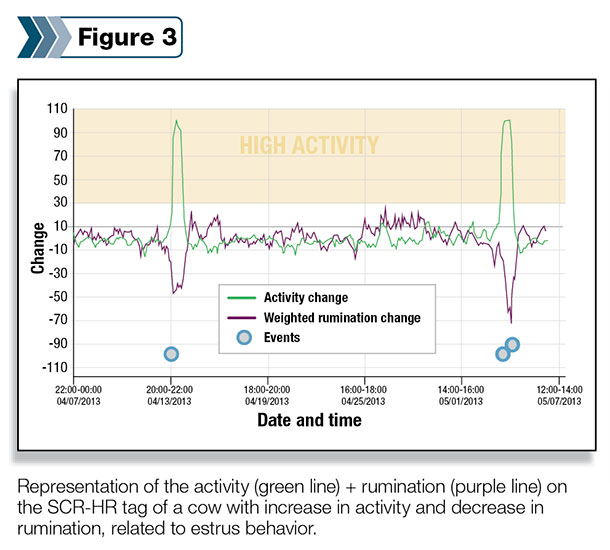
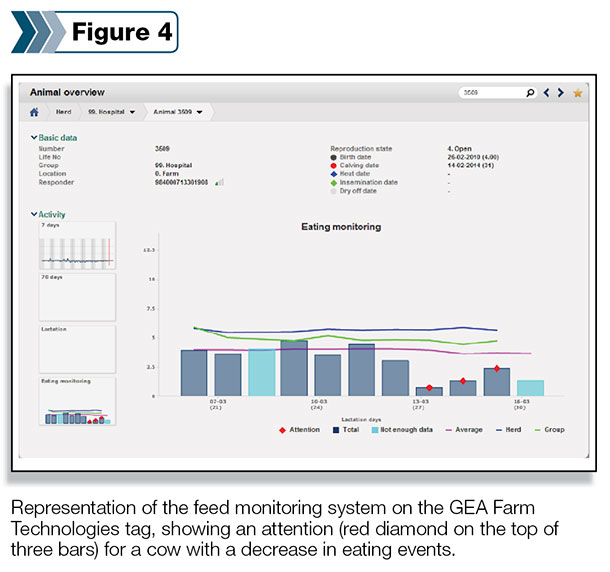
Research centers in the U.S. and Canada are working with these systems now, but not enough data had been presented to assess the quality and the confidence to meet the expectations for this great tool.
The idea is fantastic and more data will come, probably in July at the American Dairy Science Association (ADSA) annual meeting in Kansas City and in November at the Dairy Cattle Reproduction Council (DCRC) annual meeting in Salt Lake City. Be tuned for more to come after these meetings. PD
Glaucio Lopes is a veterinarian graduated from Brazil, and received his Master’s degree in Reproduction of Dairy Cows at the Department of Dairy Science at the University of Wisconsin, Madison. He is employed by Accelerated Genetics as a reproduction specialist.
Glaucio Lopes
Reproduction Specialist
Accelerated Genetics






